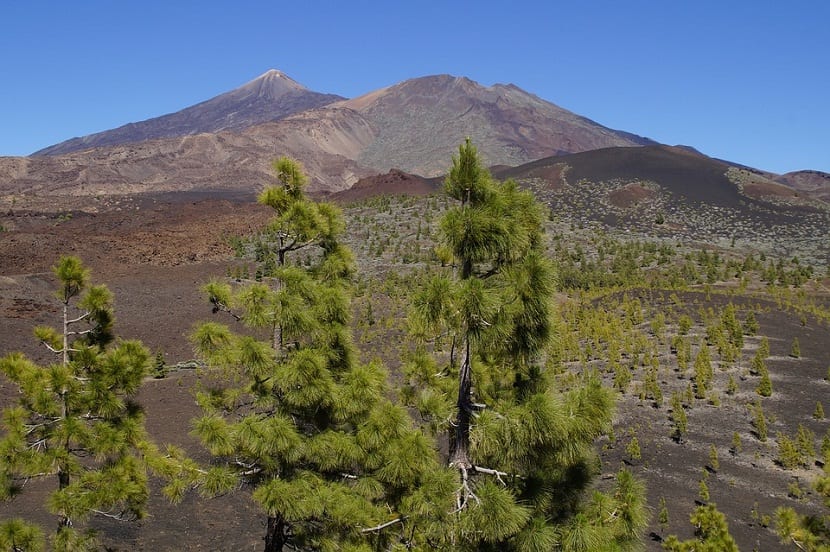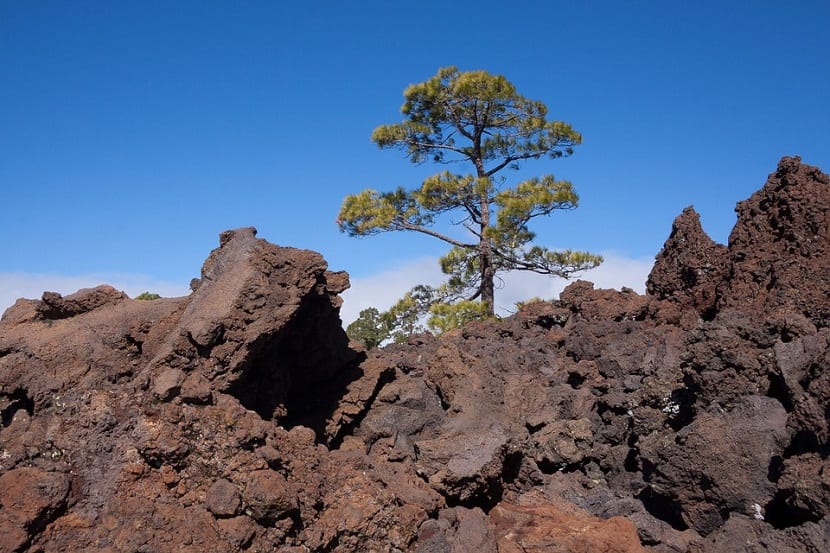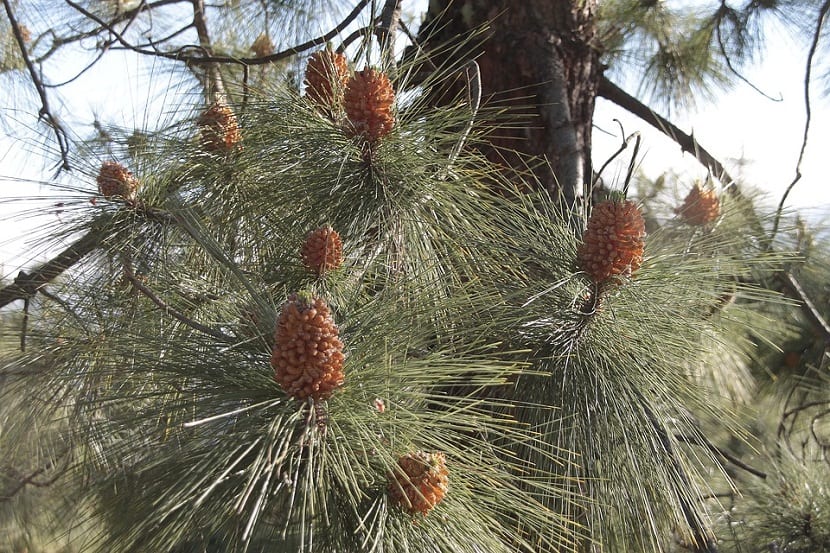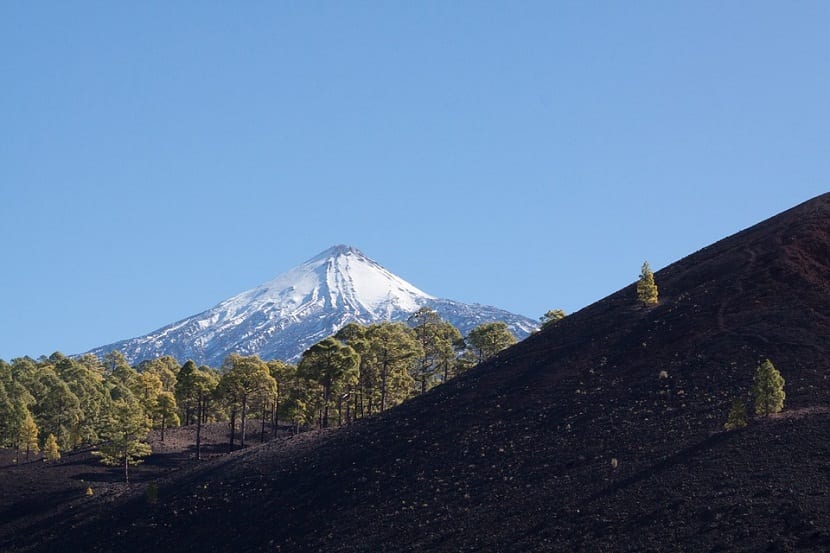
El Pinus canariensis popularly known as Canary Island pine, is one of the few autochthonous pines that can be found in the Spanish territory. This is a beautiful conifer that originates from the Canary Islands, where they have become a natural symbol for the island of La Palma.
This is a very interesting plant that can be had very easily in a garden, by having a accelerated growth and with a fairly simple cultivation, so it makes this a perfect species to have as an isolated specimen or it can also be placed as a tall hedge for protection.
Canary pine natural ecosystem

The Canary Island pine is found forming pure or mixed forests with other higher plants such as the myrica faya, Ilex canariensis or adenocarpus viscosus in the Canary archipelago, specifically the islands of Tenerife, La Palma, Gran Canaria and El Hierro, although it is also seen in La Gomera. It lives at an altitude between 100 and 2000 meters above sea level, in poor, dry soils with good drainage.
Due to its evolution, it has had to adapt to being in an environment where fires are a fundamental part of the ecosystem, so today it is one of the species that best resists fire, sprouting shortly after the fire has been extinguished.
If we talk about the weather, the average temperature is between 15 and 19ºC, with rainfall of between 300 and 600mm, so that its growing season lasts a good part of the year.
Features
A Canary Island pine tree in its adult stage can have a measure that can reach 40 meters in height with 2,5 meters in diameter at the trunk, despite the fact that the most common is that it is only about 15 or 25 meters high and with a diameter of at least one meter.
The bark that this tree has is of a light brown color and is generally practically smooth in the trees that are younger, but when they age this one thickens pretty fast and it also cracks more easily, taking on a slightly more brownish-red color.
Those specimens that are much older have a rhytidoma that is quite thickened as well as irregular, and form plates that are smooth and they are shaped like glasses. They generally have a gray color similar to ash.
During his first years of life this tree usually grows quite fast, with its branches arranged horizontally and with abundant secondary ramifications that are erect, making the appearance of said tree have a pyramidal shape. Later when the growth with respect to the height ceases, it happens to have a parasol shape.
The leaves of this plant are green, acicular, which have their development on top of the shoots of that year, straight and yellowish in color that grow in thick buds, with an oval-cylindrical shape and that are covered by membranous scales of a reddish-brown color.
This is a pine that has three needles for each pod and it is the only one of its kind found in western Eurasia, so the closest one is in the Himalayas, being very similar to the Canary Island pine.
Its flowering time goes from March to May. The male inflorescences are separated from the female ones, since those that are masculine are in some spikes that are conical and about 5 to about 10 centimeters long, with a yellow color with shades of green that are made up of many stamens that have an enormous amount of pollen.
The flowers that are female are found in some mutual strobili that they have a green color with shades of red and that when they mature they become cones or cones that are reddish-brown in color as well as glossy, and that can be between about 12 to about 18 centimeters long with a diameter of between about 8 to about 10 centimeters in the part that is widest.
The fruit is formed by scales that are settled along the entire length of an axis that is woody and that only opens when the climatic conditions are suitable, especially when there is dryness in the environment. When the optimal conditions are given, they separate said scales or the cone of the plant falls by releasing the pinions when they hit the ground.
Canary Island pine care and cultivation

The reproduction of the Pinus canariensis it is made by means of seeds. In the spring season some seeds are introduced into the substrate and then a centimeter of soil is placed on these, always maintaining the humidity of the substrate. Before planting it is recommended to place the seeds in water for 24 hours; after a week they begin to germinate, being essential to maintain the suitable temperature to prevent the appearance of certain fungi.
One of the peculiarities that this species of pine has is that has buds on the wood, making it possible for it to sprout again once pruned and also in the event of a fire.
This type of tree does not need very specific care or maintenance as in the case of agricultural crops, however, require important characteristics in the soil and climate.
These species of pines prefer sandy and slightly acidic soilsHowever, it can withstand clay and limestone soils because it has the ability to survive in virtually any environment.
This is one of the reasons why many people tend to come across pine nuts almost anywhere. Despite being a fairly resistant tree, it is important to avoid planting them in areas vulnerable to waterlogging.
They do not need a large amount of water to survive, in fact, are able to tolerate high temperatures as long as they do not exceed 40 ° C. Low temperatures do not seem to be a problem either, since they can resist -20 ° C, however, at -10 ° C it can present serious damage to leaves and tissues.
Main uses of Pinus canariensis
El Pinus canariensis it has great value at the forest level. This particular species is widely used for reforestation, due to the quick adaptation to any type of soil and after a short time it takes to grow, especially in those poorly evolved soils.
Another of its great uses is carpentry, especially semi-hard species, since the tea pines are quite scarce mostly due to the great demand for wood.
For its part, the white wood obtained from these pines is used to make some wooden articles, while the wood of tea, is used mainly in carving and cabinetmaking. Previously, this type of wood was used to make the roofs of houses and churches.
Canary Island pine is also widely used due to its medicinal properties, since it is very good for treating respiratory problemsAs well as asthma and bronchitis, its resin is applied to remove certain cysts and also to protect against fire and some insects.
Plagues and diseases

Despite being a fairly resistant tree not only to environmental conditions but also to forest disasters, there is a plague that can cause them a lot of damage these and is known as the pine processionary.
These caterpillars are capable of stopping the development of the vast majority of pine species, making them vulnerable to attack by other pests. Fortunately, these caterpillars can be exterminated with the help of some chemicals that can prevent uncontrolled spread.